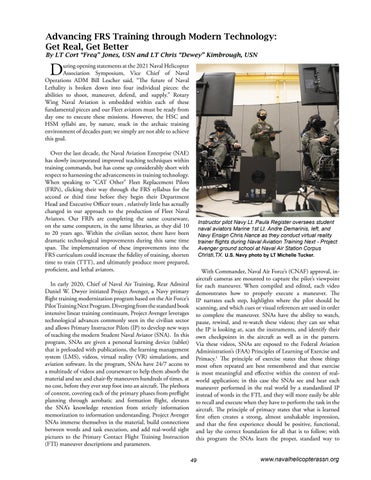Advancing FRS Training through Modern Technology: Get Real, Get Better By LT Cort “Freq” Jones, USN and LT Chris “Dewey” Kimbrough, USN
D
uring opening statements at the 2021 Naval Helicopter Association Symposium, Vice Chief of Naval Operations ADM Bill Lescher said, “The future of Naval Lethality is broken down into four individual pieces: the abilities to shoot, maneuver, defend, and supply.” Rotary Wing Naval Aviation is embedded within each of these fundamental pieces and our Fleet aviators must be ready from day one to execute these missions. However, the HSC and HSM syllabi are, by nature, stuck in the archaic training environment of decades past; we simply are not able to achieve this goal. Over the last decade, the Naval Aviation Enterprise (NAE) has slowly incorporated improved teaching techniques within training commands, but has come up considerably short with respect to harnessing the advancements in training technology. When speaking to “CAT Other” Fleet Replacement Pilots (FRPs), clicking their way through the FRS syllabus for the second or third time before they begin their Department Head and Executive Officer tours , relatively little has actually changed in our approach to the production of Fleet Naval Aviators. Our FRPs are completing the same courseware, on the same computers, in the same libraries, as they did 10 to 20 years ago. Within the civilian sector, there have been dramatic technological improvements during this same time span. The implementation of these improvements into the FRS curriculum could increase the fidelity of training, shorten time to train (TTT), and ultimately produce more prepared, proficient, and lethal aviators. In early 2020, Chief of Naval Air Training, Rear Admiral Daniel W. Dwyer initiated Project Avenger, a Navy primary flight training modernization program based on the Air Force’s Pilot Training Next Program. Diverging from the standard book intensive linear training continuum, Project Avenger leverages technological advances commonly seen in the civilian sector and allows Primary Instructor Pilots (IP) to develop new ways of teaching the modern Student Naval Aviator (SNA). In this program, SNAs are given a personal learning device (tablet) that is preloaded with publications, the learning management system (LMS), videos, virtual reality (VR) simulations, and aviation software. In the program, SNAs have 24/7 access to a multitude of videos and courseware to help them absorb the material and see and chair-fly maneuvers hundreds of times, at no cost, before they ever step foot into an aircraft. The plethora of content, covering each of the primary phases from preflight planning through aerobatic and formation flight, elevates the SNA’s knowledge retention from strictly information memorization to information understanding. Project Avenger SNAs immerse themselves in the material, build connections between words and task execution, and add real-world sight pictures to the Primary Contact Flight Training Instruction (FTI) maneuver descriptions and parameters.
Instructor pilot Navy Lt. Paula Register oversees student naval aviators Marine 1st Lt. Andre Demarinis, left, and Navy Ensign Chris Nance as they conduct virtual reality trainer flights during Naval Aviation Training Next - Project Avenger ground school at Naval Air Station Corpus Christi,TX. U.S. Navy photo by LT Michelle Tucker.
With Commander, Naval Air Force’s (CNAF) approval, inaircraft cameras are mounted to capture the pilot’s viewpoint for each maneuver. When compiled and edited, each video demonstrates how to properly execute a maneuver. The IP narrates each step, highlights where the pilot should be scanning, and which cues or visual references are used in order to complete the maneuver. SNAs have the ability to watch, pause, rewind, and re-watch these videos; they can see what the IP is looking at, scan the instruments, and identify their own checkpoints in the aircraft as well as in the pattern. Via these videos, SNAs are exposed to the Federal Aviation Administration’s (FAA) Principles of Learning of Exercise and Primacy.1 The principle of exercise states that those things most often repeated are best remembered and that exercise is most meaningful and effective within the context of realworld application; in this case the SNAs see and hear each maneuver performed in the real world by a standardized IP instead of words in the FTI, and they will more easily be able to recall and execute when they have to perform the task in the aircraft. The principle of primacy states that what is learned first often creates a strong, almost unshakable impression, and that the first experience should be positive, functional, and lay the correct foundation for all that is to follow; with this program the SNAs learn the proper, standard way to 49
www.navalhelicopterassn.org





































